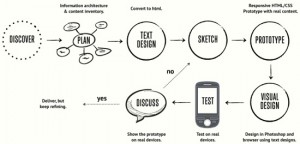
In 2000, The FWA (a popular website awards program) gave their prestigious Site of the Year award to Look and Feel New Media, shown below. Visit the site for some context of what I’ll be discussing, but turn down your speakers or headphones because it has background music.
The Look and Feel New Media site is a simple Flash website by today’s standards, but it was state of the art back when Flash was an innovative web technology.
Now, thirteen years later, with the capabilities of HTML5 and CSS3 standards, Flash is now on the way to extinction in the sense of, at the very least, modern web design and development.
Even Flash technology’s owner, Adobe, decided to discontinue the development of this ubiquitous rich media platform’s mobile version.
So what does this have to do with responsive web design (RWD)?
Well, responsive web design has gained an enormous amount of momentum since its introduction in 2010 through an article named “Responsive Web Design” published on A List Apart.
And the design philosophy’s popularity today is comparable to Flash websites in the early-2000s.
Let me state that Flash is a technology, whilst responsive web design is a device-independent design philosophy, so that is not a direct, apples-to-apples comparison.
However, it’s a parallel to hopefully open our minds when considering the ever-attractive design philosophy that is responsive web design.
Just as HTML survived the Flash versus HTML debate of the last decade, I believe we should not write off other mobile development techniques and alternatives just yet.
Below, I will discuss some issues I’ve come to realize with responsive web design (RWD).







